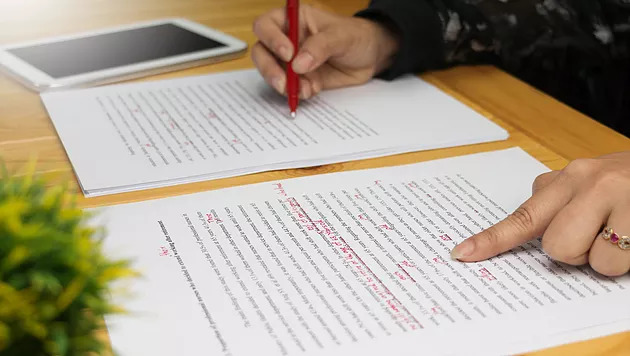What Is a Bid Writer & Bid Writing?

What Does A Bid Writer Do?
A bid writer’s core job is to craft a company’s response to a Request for Proposal (RFP), Invitation to Tender (ITT), or similar tender documents. Their ultimate goal? To help the organisation win the deal by creating a clear, compelling, and compliant submission that resonates with the client’s needs and priorities.
A bid writer’s job is about more than just writing — it’s about weaving together diverse inputs into a cohesive narrative. They gather insights from sales, operations, finance, legal, and subject matter experts, translating these into concise, persuasive responses that show the client why your organisation is the best choice.
In practice, a bid writer’s day might look like this:
- Researching the client, their challenges, and what matters most to them.
- Coordinating inputs from multiple teams and ensuring everyone stays aligned.
- Writing, reviewing, and refining responses to ensure they are clear, persuasive, and compliant.
- Managing deadlines to make sure the final proposal is submitted on time and in full.
Every word must count, every section must build confidence, and every response must demonstrate why your organisation stands out from the competition. It’s high-pressure, detail-driven work that sits at the intersection of storytelling and precision.
In short, a bid writer is the link between a company’s capabilities and the client’s needs. They connect the dots, crafting submissions that don’t just check the boxes but inspire confidence, build trust, and win work.
The Core Responsibilities of a Bid Writer
Research and Strategy
Bid writers don’t just respond to RFPs and ITTs — they dig deeper to understand the client’s goals, challenges, and priorities. They analyse everything from annual reports to buyer communications, looking for insights that can shape a winning proposal. Armed with this research, bid writers craft a winning strategy: identifying the strengths to highlight, differentiating your solution from competitors, and aligning every response with the client’s evaluation criteria.
Writing and Compliance
Writing is at the heart of a bid writer’s role. They take technical details, logistics, pricing, and input from various teams and turn it into clear, engaging language that speaks directly to the client. They cut through the jargon, ensuring every word resonates and drives the message home.
Equally vital is compliance. A bid writer ensures every detail meets the client’s requirements and regulatory standards. They cross-check responses against criteria, confirm legal and financial accuracy, and include all required documents – to underpin a proposal that is credible, professional, and impossible to ignore.
Collaboration Across Teams
Bid writing is a team effort, and a great bid writer serves as the hub that connects multiple departments. They gather input from:
- Sales and Account Management for client insights and strategic intelligence.
- Finance to ensure pricing is competitive and realistic.
- Legal to confirm contracts and terms meet compliance standards.
- Operations for delivery plans, including staffing, timelines, and logistics.
- HR to showcase recruitment strategies, personnel qualifications, and retention plans.
- Marketing for case studies, success stories, and evidence to back up claims.
- ICT for technical details about software, systems, and infrastructure.
- Subject Matter Experts (SMEs) for the deep technical expertise that bid writers turn into persuasive, client-focused language.
Bringing all these elements together, a bid writer transforms complexity into clarity. They craft a compelling case that sets your organisation apart from the competition and builds confidence with the client.
Skills and Traits of a Great Bid Writer
Being a great bid writer isn’t just about writing well, but fundamentally, they must be able to write well. If they can’t adapt their writing style to the client, the tone of voice and corporate style of your company, or the specific needs of a bid, they’ll never be a great bid writer. Writing is the absolute foundation of the role, and a great bid writer will put in the time to learn how to write clearly, persuasively, and precisely.
Writing With Persuasive Clarity
A great bid writer is not only someone who can write well but also someone who can adapt their style to suit the context. Every bid has its own tone, and the ability to switch from technical precision to storytelling, depending on the client’s needs, is critical. Writing a clear and compelling response that strips away jargon and focuses on what the client really cares about is the bid writer’s art. Mastering this skill is non-negotiable.
Analytical and Research Skills and Curiosity
Bid writers need to dig deep and sift through large volumes of data to uncover insights that will help position their proposal strategically. A great bid writer doesn’t rely on the information handed to them. This curiosity will also drive them to learn more about their craft and get better.
Collaboration and Project Management Skills
Bid writing is rarely a solo job. The bid writer needs to collaborate with multiple departments — finance, legal, operations, HR, and ICT, all while managing tight deadlines and shifting requirements. Project management skills are critical. A great bid writer keeps everything moving forward, coordinating input and ensuring every piece fits seamlessly into the final submission.
Resilience and Adaptability
Bid writing can be grueling, with tight deadlines, last-minute changes, and the constant pressure of competition. A great bid writer can pivot when necessary, rewrite sections under pressure, and keep the team focused on delivering a winning submission, no matter the challenges.
Emotional Intelligence
A great bid writer doesn’t just understand what the client is asking for on paper, they’re able to read between the lines. Emotional intelligence helps bid writers address the unspoken concerns and priorities of the client, which can make the difference between a win and a loss. Emotional intelligence also plays a key role internally, enabling bid writers to manage relationships and team dynamics effectively, particularly when tensions run high.
How Has the Role of the Bid Writer Evolved?
Bid writing has always required a mix of creativity, precision, and collaboration. But over the years, the tools and processes that support bid writers have transformed the role dramatically.
From Manual Chaos to Digital Collaboration
Two decades ago, bid writing was a labour-intensive process. Writers managed mountains of paperwork, chased down inputs through endless email threads, and manually pieced together compliance requirements. The introduction of tools like SharePoint and Google Docs brought some order to the chaos, enabling real-time collaboration and document control. Platforms like Microsoft Teams and Slack further streamlined communication, making it easier for bid teams to align across departments without missing a beat.
The Age of AI and Automation
With each new innovation, the expectations of bid writers evolve. The most profound shift in bid writing is the adoption of AI-driven tools like AutogenAI. Today, AutogenAI isn’t just helping bid writers move faster and deliver with higher accuracy — it’s setting a new and higher standard. Teams can now produce more proposals in less time, all while maintaining compliance and crafting compelling responses. Without AutogenAI, keeping up with these demands is a near-impossible challenge. AutogenAI tackles the time-consuming, repetitive tasks that once bogged down bid writers, freeing them to focus on what they do best: storytelling, strategy, resonating with clients and winning work.
New Tools That Enhance Bid Writers’ Talent
At AutogenAI, we’re changing the way bid writers work, enabling them to focus on crafting winning strategies and compelling narratives by taking on the most labor-intensive tasks. Here’s how:
- Rapid Opportunity Qualification: AutogenAI scans and extracts the critical information from complex RFPs, eliminating hours of manual searching.
- Smart Questionnaire Filling: Automatically populates pre-qualification questionnaires (PQQs) using stored templates and past responses, saving time and reducing errors.
- Task Management & Storyboarding: Provides a structured breakdown of the bid process, assigning responsibilities for writing, reviewing, and approvals. Integrated compliance matrices ensure nothing is missed.
- Research Support: Instantly pulls insights from internal libraries, industry reports, and public data, synthesising them to reduce hours of research into minutes.
- First Draft Generation: Delivers structured, evidence-based drafts drawn from your previous bids and data sources. Writers refine these drafts, ensuring they reflect your voice and strategy.
- AI Toolbox: Features like Case Studies, Evidence, Summarise, Expand, and How To make editing and drafting faster and more precise:
- Case Studies: Generates client-specific examples from stored data.
- Evidence: Validates and inserts data to back up claims.
- Summarise & Expand: Condenses or elaborates content as needed.
- How To: Builds step-by-step guides for complex processes.
- Compliance Built-In: Cross-references bid responses with buyer requirements and regulatory standards, minimising the risk of disqualification.
- Editorial Precision: Automated reviews catch errors, ensure completeness, and check tone and branding, giving teams confidence to submit high-quality proposals.
By combining AI’s speed and precision with human creativity and expertise, AutogenAI allows bid writers to achieve more — producing polished, persuasive bids faster and with greater accuracy.
The Future: Blending Technology with Human Expertise
Bid writing has always been a blend of art and science. AutogenAI can handle technical tasks — research, drafting, compliance — with speed and accuracy, but they’re absolutely not a replacement for human creativity and judgment.
The real magic happens when bid writers make the most of AI and use it to help them focus on crafting responses that resonate with clients, telling compelling stories, underpinned by robust evidence, that inspire confidence and set their bids apart. As Sean Williams, CEO of AutogenAI, says: “Proposals are 70% writing, and 30% admin. Writing is what wins. Everything else just supports that.”
As the bid writing landscape evolves, it’s more important than ever for bid writers to embrace new tools while honing their skills. Technology can do the heavy lifting, but it’s their strategic thinking, empathy, and expertise that will make your bids stand out.
By blending cutting-edge tools with human insight, bid writers are delivering smarter and more compelling proposals — ones that win work and build lasting client relationships.
To learn more about AutogenAI, contact us today.
Frequently Asked Bid Writing Questions
What is bid and tender writing?
Bid and tender writing is the process of preparing written responses to formal procurement documents such as Requests for Proposals (RFPs), Invitations to Tender (ITTs), or Pre-Qualification Questionnaires (PQQs). The goal is to persuade a buyer—often in the public sector—that your organisation is the best choice for the contract.
What is involved in the bid writing process?
The bid writing process includes opportunity qualification, gathering insights, coordinating with stakeholders, writing responses, ensuring compliance, reviewing submissions, and managing deadlines. It requires strong project management skills, collaboration, and the ability to write clearly and persuasively.
What is the success rate for bid submissions?
A successful bid depends on multiple factors: understanding the client’s needs, strong strategy, clear writing, and compliance. While success rates vary by industry and sector, organisations using tools like AutogenAI to streamline the process and produce high-quality proposals typically see higher win rates.
Why are clarification questions important during bidding?
Clarification questions help bidders seek additional information from the buyer to ensure their submission aligns with expectations. They are vital for interpreting vague requirements, reducing the risk of disqualification, and enhancing the relevance of your response.
Can I receive training in bid writing?
Yes. Bid writing training is available for individuals and teams looking to strengthen their skills in persuasive writing, strategy development, compliance, and proposal management. With the rise of AI tools, training now also includes how to best leverage platforms like AutogenAI in the bidding process.
What does a bid writer do in the public sector?
In the public sector, a bid writer crafts proposals to win government or publicly funded contracts. These tenders often require strict compliance with procurement regulations and detailed responses to evaluation criteria, making precision and clarity essential.
How do bid teams manage multiple bids at once?
To manage multiple bids, bid teams use project management tools, templates, and now increasingly, AI-driven platforms like AutogenAI. These systems help track progress, assign tasks, and maintain consistency across submissions—ensuring quality and timely delivery even under pressure.
What makes a bid successful?
A successful bid is one that clearly addresses the buyer’s needs, aligns with evaluation criteria, and demonstrates value, credibility, and capability. Strong research, persuasive writing, and strategic use of data and case studies all contribute to a winning submission.
How do I manage multiple stakeholders during the bid process?
To manage multiple stakeholders, a bid manager plays a key role—coordinating input from sales, finance, legal, operations, and subject matter experts. Tools like AutogenAI help organise content, maintain version control, and streamline collaboration.
Why is it important to work closely with internal teams?
To write a strong bid, you must work closely with teams across your organisation. Their insights, data, and expertise provide the foundation for compelling, accurate, and compliant proposals. A bid writer’s job is to unify these contributions into a cohesive response.
How does the procurement process affect bid writing?
The procurement process sets the structure and rules for bidding. Understanding this process—especially in the public sector—is crucial for compliance and competitiveness. It informs how bids are evaluated and what documentation must be included.
What is the role of a bid manager?
A bid manager oversees the end-to-end bid process, ensuring timelines, tasks, and reviews are on track. They coordinate contributors, manage risk, and ensure quality assurance. Their leadership is essential to delivering professional, compliant, and competitive bids.


